



The giant neon sign stood tall at 6205 El Cajon Boulevard all through the 60’s and 70’s feeding legions of San Diego State students, locals, and tourists alike. It boasted a half million customers a year pulling up a tray to the carving stations and food line.

“The policy of giving the people what they want in the way of price–service–and quality has made the CAMPUS CHUCK WAGON on of the outstanding eating attractions in the Far West.”




Note: MidCentury View and San Diego Historic Neon are dsoderblog managed pages on Facebook.




With a triangular stone wall rising from a promontory along the coast of Carmel, the 1952 “Cabin on the rocks” built for Della Walker is a jewel in the Frank Lloyd Wright portfolio and among his best Usonian designs.

The most dramatic element of the house is the prow-shaped wall built of Carmel Stone, jutting into the Pacific Ocean. The hexagonal-shaped living room space, framed in stepped horizontal mullions and glass, rises out of the stone prow providing a panoramic view of the surrounding ocean and beach scape.

The Walker Residence is the only Usonian design completed by Wright in a coastal environment. He previously had clients owning coastal sites but those plans were never built. Wright found the Carmel beach site compelling, and at a time in his career when he and the Fellowship were exceptionally in demand, he personally supervised this project from beginning to end.

The hexagonal living room space framed by seemingly seamless bands of reverse-stepped glass panels. The design not only provides a distinct look, but had a unique functionality – there are vents under the windows which are opened and closed with sliders allowing for air but not stiff wind or ocean spray.

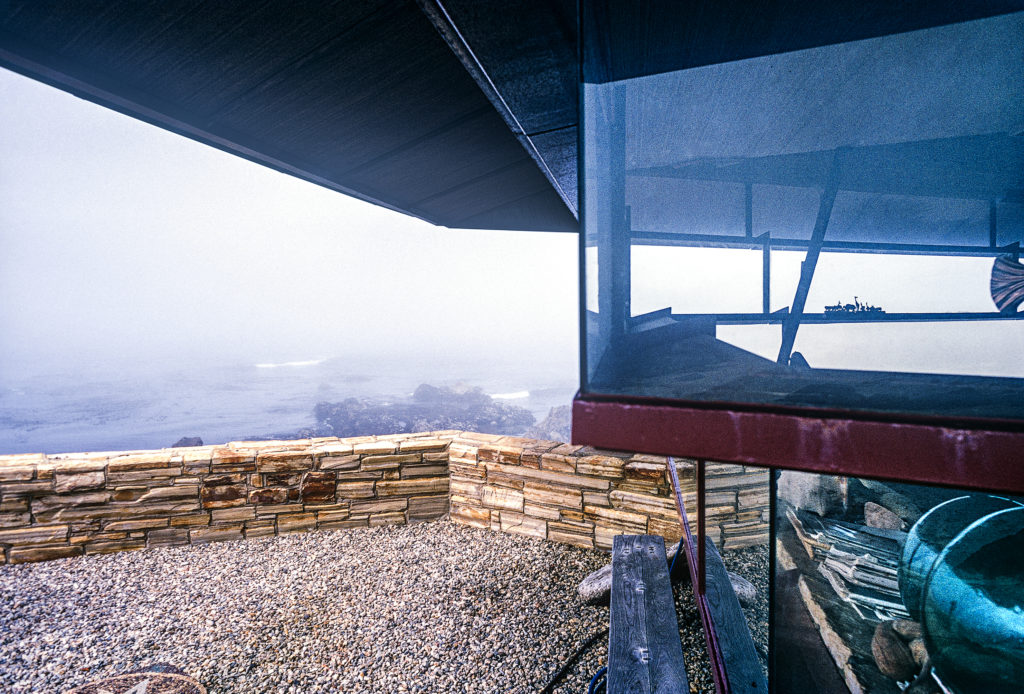

Luckily this architectural treasure remains in the family. Della Walker was still residing here when I shot these photos. While my memory isn’t perfect either her or another family member were very accommodating of my photo project, allowing me a second session a few days later under sunny skies.
Della Walker passed away in 1978 at age 100.
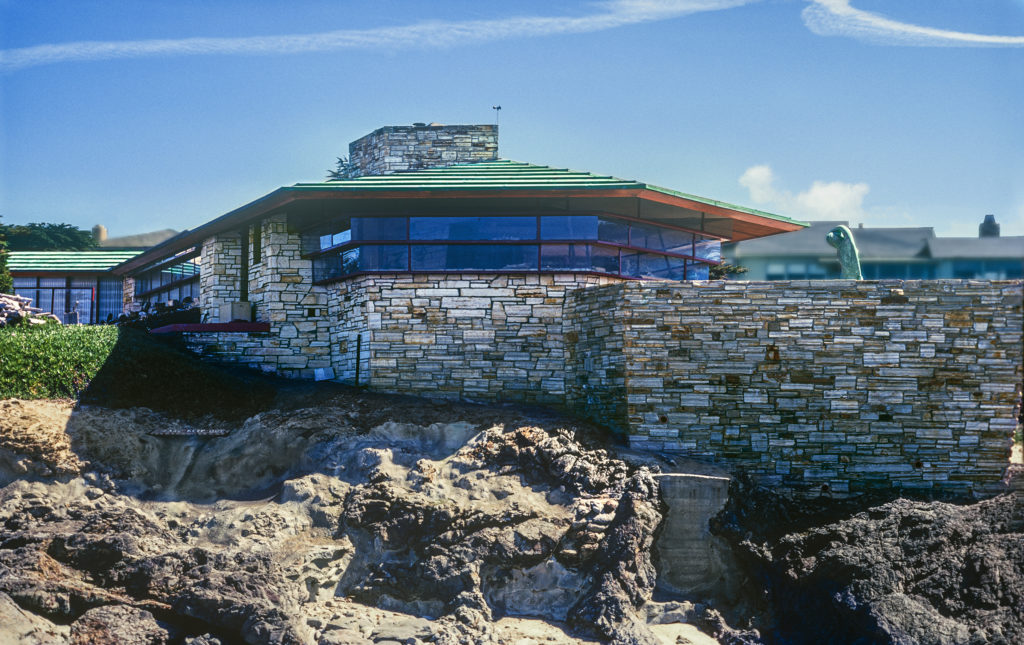
Della Walker’s great grandson Chuck Henderson took a passion for the house, is a dedicated preservationist, and has spearheaded extensive restoration of this National Register Historic Site. When the house was designated, the report pointed the prow wall needing significant work to stabilize the structure and site.
“The primary condition issue is undermining of the Carmel stone ship’s prow wall by wave action. This condition needs to be addressed to ensure preservation of the building.”
Doing that was no small feat, but thanks to Mr. Henderson the job got done.
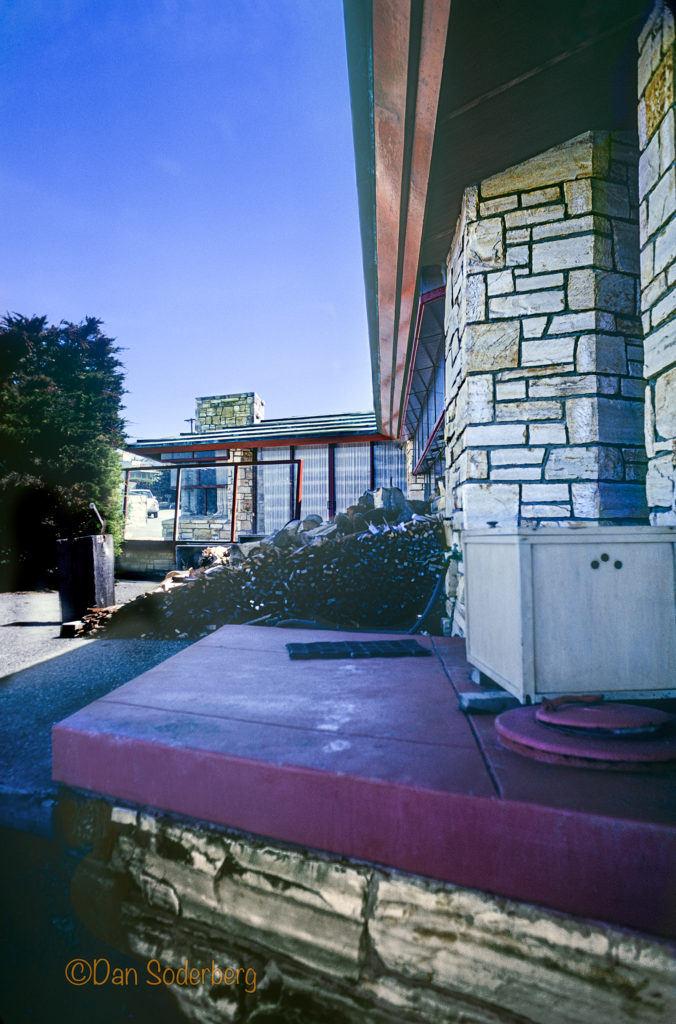

The Walker House is a private residence, Please respect the owner’s privacy. Today very visible signs indicate that it is private property / no trespassing and that there is video recording going on.
Best option for viewing is to contact Carmel Heritage Society for specific dates and times the organization will host tours. https://www.carmelheritage.org/

As I recall this is the entrance to the kitchen. Wright objected to the notion of having any visible trash cans sitting outside the door of his masterpiece. In fact he didn’t originally want to have a kitchen door to avoid that. Finally a compromise was made to provide that door as long as the trash cans were out of view.

Firewood for the home’s fireplaces. In view, the smaller chimney. But the home’s star fireplace is the tall one in the hexagonal living room.
Henderson says it “really cranks.”
He also noted that firewood is no longer stored at this spot, but rather in a wood shed along the fence.

The Alliance of Monterey Area Preservationists, AMAP, awarded Chuck and Kit Henderson as preservationists of the year for their general care of the house, which remains essentially unchanged, including an original Thermador oven. “I think it’s an honor to be able to be a steward of such a unique place on Earth,” Henderson said.
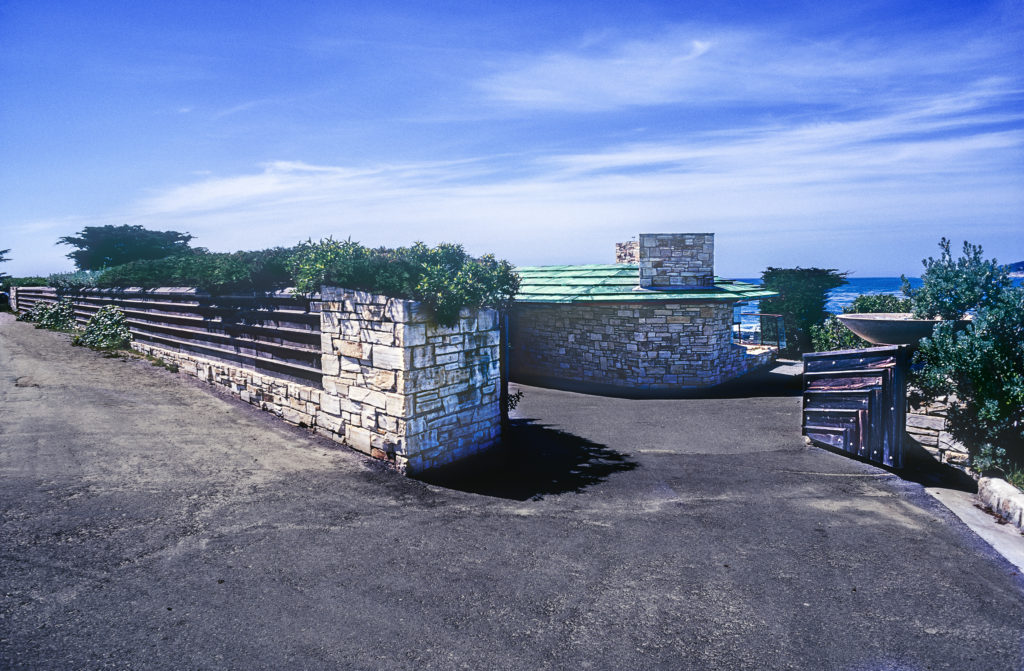
As so often the case with a Wright project the street view is the most discrete elevation of the house. When I visited the gates were open. But when closed, there are few site lines of the house from the street.
To provide adequate privacy, Wright had the lot lowered four feet to enable the house to melt into the landscape, and planted a cypress hedge for privacy along the south property line that runs down Scenic Road.
Among the restoration work on the site – replacing and replicating the redwood fencing and Wright designed gate doors.

An asphalt driveway leads from Scenic Road down to the house.
Gotta love the Mercedes parked in the carport!

You know it’s a Wright when…

The Walker House property is a 9,170 sq. ft. triangular lot located north of Scenic Road, approximately 1\4 mile west of Martin Way.

The 1952 painted metal roof was replaced with copper in 1956. It was replaced again, well after this photo, in 1997 to the same 1956 specifications.

Another significant site character defining feature is the Thomas Church-designed landscape consisting of large stones, raked gravel and Coastal plants.
References include the article by Dave Weinstein, and the National Register of Historic Places Registration Report Also thanks to Chuck Henderson and Kathryn Smith. Their input is much appreciated.




It’s the 1929 Spanish Colonial Revival theater in the heart of downtown Riverside, California. Like many great buildings of it era, it had its heyday and decline. But what stands out here, the site was saved and brought back to its former glory as an up to date regional performing arts center.
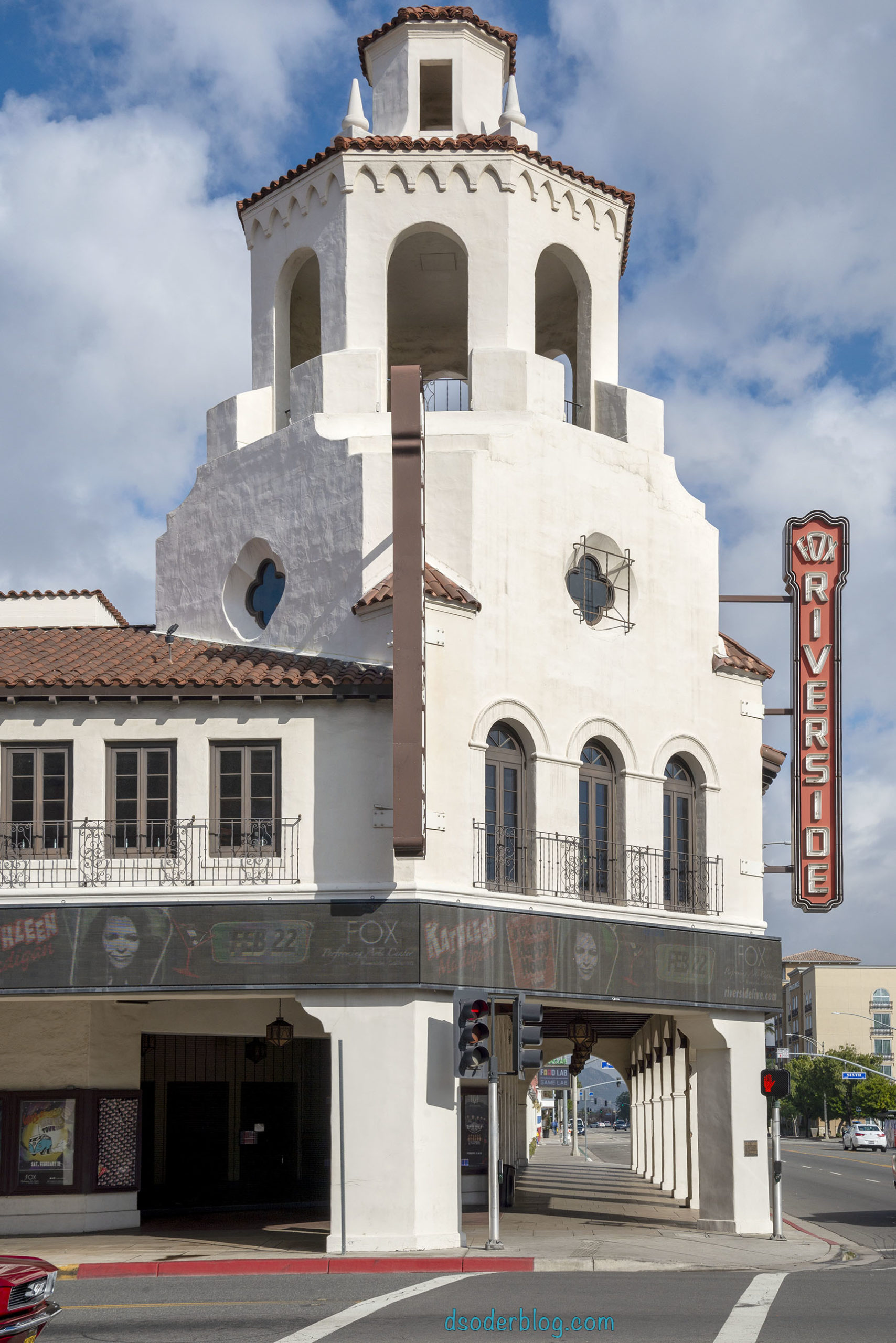
It was the first theatre to screen Gone With The Wind, one of the gold-standards of all time successful films. Hollywood liked to have test screenings here because it wasn’t “big city.” and Riverside better reflected how middle America would react.

The Riverside Fox Theater was designed by Los Angeles-based architects Clifford Balch and engineer Floyd E. Stanberry, who were responsible for designing many of the Fox West Coast Theaters. Some 58 theaters in total by Balch.

The Fox Riverside is a perfect example of the undeniable attractiveness of original historic fabric. The unmatched beauty achieved by original design integrity. A far superior option than demolition and replacing with bland generic cookie cutter junk.

Stenciled beams and light fixture of the Fox Riverside.
The San Diego regional portfolio of Clifford Balch includes the Adams Theatre in Normal Heights, Aztec Theatre (now basically a stripped hull used for Urban Outfitters 665 5th Avenue), and the Sunshine Brooks Theatre 217 North Coast Highway, Oceanside. And once upon a time the Balch and Strawberry Palomar Theatre 314 N. Coast Highway. Now long gone.




Last but not least the historic neon blade sign. A beauty and landmark in its own right.


In a Preservation story that began in 2005, some 14 years later a milestone was reached in Amboy with the 2019 relighting of the landmark Route 66 neon sign – Roy’s Motel Cafe. One of the most recognized sites associated with that legendary historic highway.

Amboy exists from as early as 1859. And like a lot of sites that sprinkle the Mojave map it came about because of the emergence of railroads and mineral discovery. It became a town in 1883. But the opening of Route 66 in 1926 is what gave Amboy life. Its isolated spot in the Mojave worked strategically well for weary travelers needing gas, a place to sleep, and eat.

Roy was Roy Crowl who opened the gas station here in 1938. In the 1940’s Roy’s stayed open 24 hours and expanded operations with the addition of the cafe and motel. Post World War II Amboy was hopping with business.

The Googie elements, the office and magnificent neon sign – which make the site so recognized and beloved – were added in 1959.

But it was the Interstate that killed Amboy, when I-40 bypassed the town in 1973. Amboy eventually became a ghost town.
But fast forward to 2005 when a chain of chicken restaurants came to the rescue. It was Albert Okura The Chicken Man, founder of Juan Pollo Chicken, with operations in 28 Southern California locations.
One location is on Historic Route 66 in San Bernadino. At the same spot Okura operates a Route 66 museum. Also nearby he owns the site of the very first McDonalds restaurant site. The McDonald’s building no longer exists, and you can’t buy hamburgers there. But there is a McDonald’s museum on the property.
Okura’s dream is to have the entire site at Amboy, the Motel, Cafe, and gas station, in full operation once again. Restore it and they will come seems to be his driving belief.


Only a puddle remains where the historic Summit Inn diner once stood. One of the most recognized roadside landmarks in all of Southern California, this beloved diner burnt to the ground during the Blue Cut Wildfires on August 16, 2016.

The history of Summit Inn dates back to 1928. It was replaced by the Summit Inn people remember today in 1952. A time when Route 66 flourished. Patron over the years include Elvis, Danny Thomas, Clint Eastwood, Pierce Brosmon, and Pearl Bailey, to mention a few.

Nearly four years after it was destroyed it appears hope has faded for rebuilding. Early-on the owners vowed to rebuild. But conceivably the cost of clearing the site and removing contaminated toxic ground soil became cost prohibitive for rebuilding the Summit Inn.



Waking up to a winter wonderland in the Mojave on November 30, 2019 as I was VW Kombi camping and road tripping.







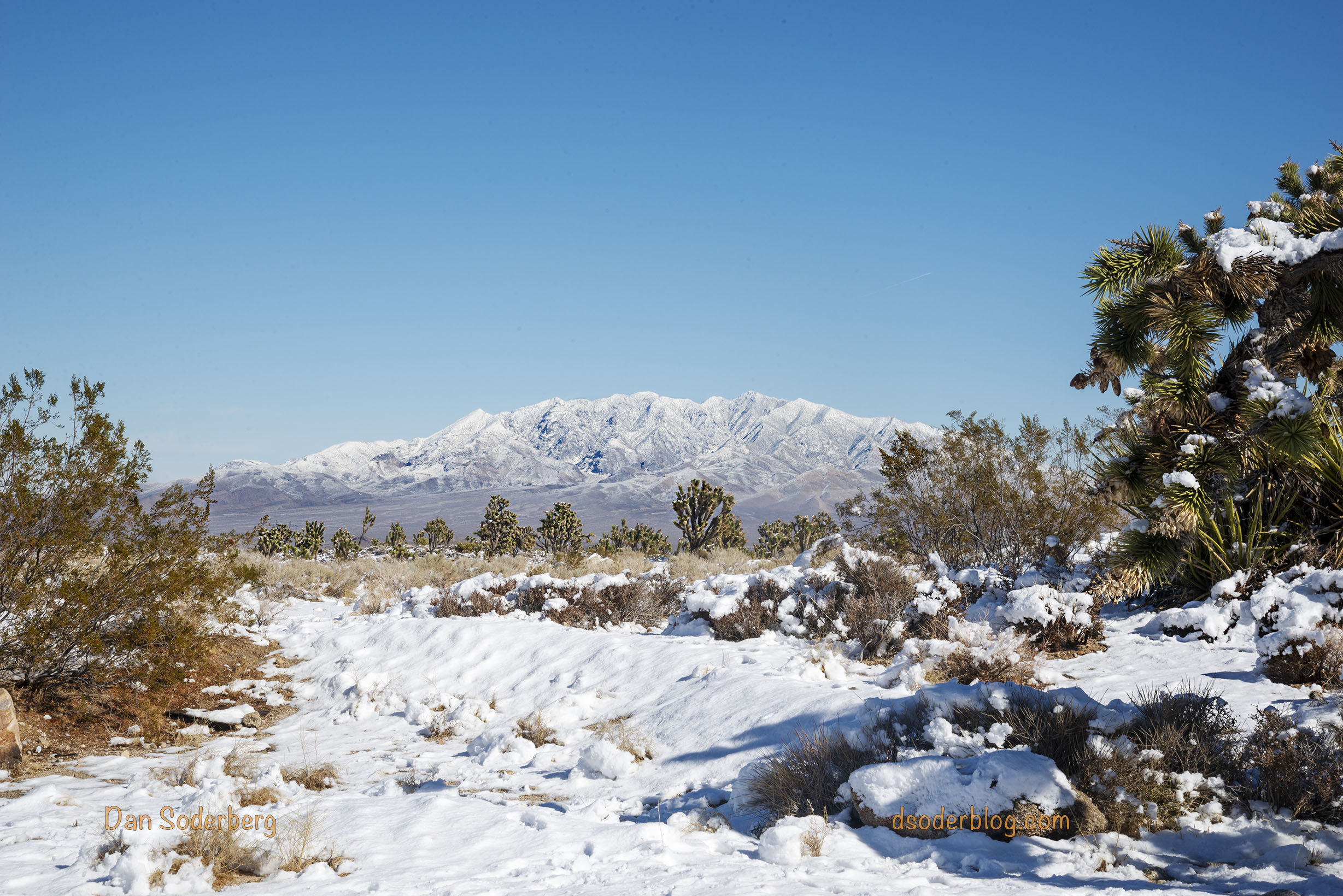


One will encounter a number of sites and markers on the trek through the Mojave National Preserve.

One is the Mojave Cross. It is officially known as the White Cross World War I Memorial.

The cross stands on Sunrise Rock, a granite outcropping adjacent to Cima Road about 12 miles south of Interstate 15.

In a story that parallels the Mount Soledad Cross story in La Jolla, there was a decades long battle over the Mojave Cross.

In April 2012, a settlement was reached to allow the cross to remain at the Mojave Land Preserve via a land swap. Five acres of private land given to the federal government in exchange for the one acre of land surrounding Sunset Rock. Ownership of that site was transferred to the local Veterans of Foreign War post.

The site is fenced, with entrances for visitors. There are benches and picnic tables. And ample signage explaining that the cross is on private land and noting it is a memorial for war veterans


Seemingly out in the middle of “nowhere” along Cima Road in the Mojave Desert, this jewel of a train station suddenly appears as a desert oasis. It’s the 1923 Kelso Train Station. Unlike the ghost town relics surrounding it, this beautiful building is in nearly pristine condition.

While the station is from 1923 the importance of the site as a railroad rest stop goes back to at least 1905 when Kelso was founded. The name was chosen purely by chance. Name rights were submitted on pieces of paper and placed into a hat. Upon draw, all at once John H. Kelso had a town named after him.

This Mission Revival and Spanish Colonial Revival design comes from the drawing boards of John and Donald Parkinson. If you don’t know their names, you certainly know their portfolio. They designed the USC Master Plan, LA Coliseum, LA City Hall, Bullocks Wilshire, Union Station, and Grand Central Market – to name a few.

The train station survives today by the sheer will of concerned citizens who stepped up to save the building from demolition when it closed as a train station in 1985. Key to this preservation effort was The National Park Service gaining control of the site in 1994 .

The building reopened to the public in 2005 as the visitor center for the Mojave National Preserve. There are interpretive displays, both inside and out, providing a valuable understanding to the historical significance of the station’s location.

It is explained why a fancy train station is in the middle of “nowhere.” One reason is an abundant supply of ground water for steam engines.
It was a “helper” station. Because of the severity of the long steep Cima Grade, helper engines were needed to assist trains on that grade. Kelso was home of those helper engines, and there was a big roundhouse there to direct, turn around, and utilize them. Kelso was the helper station in regards to fuel and water as well.

A beautifully designed building that was well used and well loved for a long time. It became affectionately known as the Kelso Club House. More than a train and ticket station it was telegraph office, restaurant, reading room, and dormitory rooms for railroad employees.

The interior has been restored and preserved as well, including the lunch room. Nice they didn’t forget to save the neon sign. However it appears it has suffered some wind damage, as the power cable was pulled out of the wall.

The focus of my photo essay is the exterior. Visitors wanting to see the Kelso Train Station inside and out – be advised they are closed Tuesdays and Wednesdays.
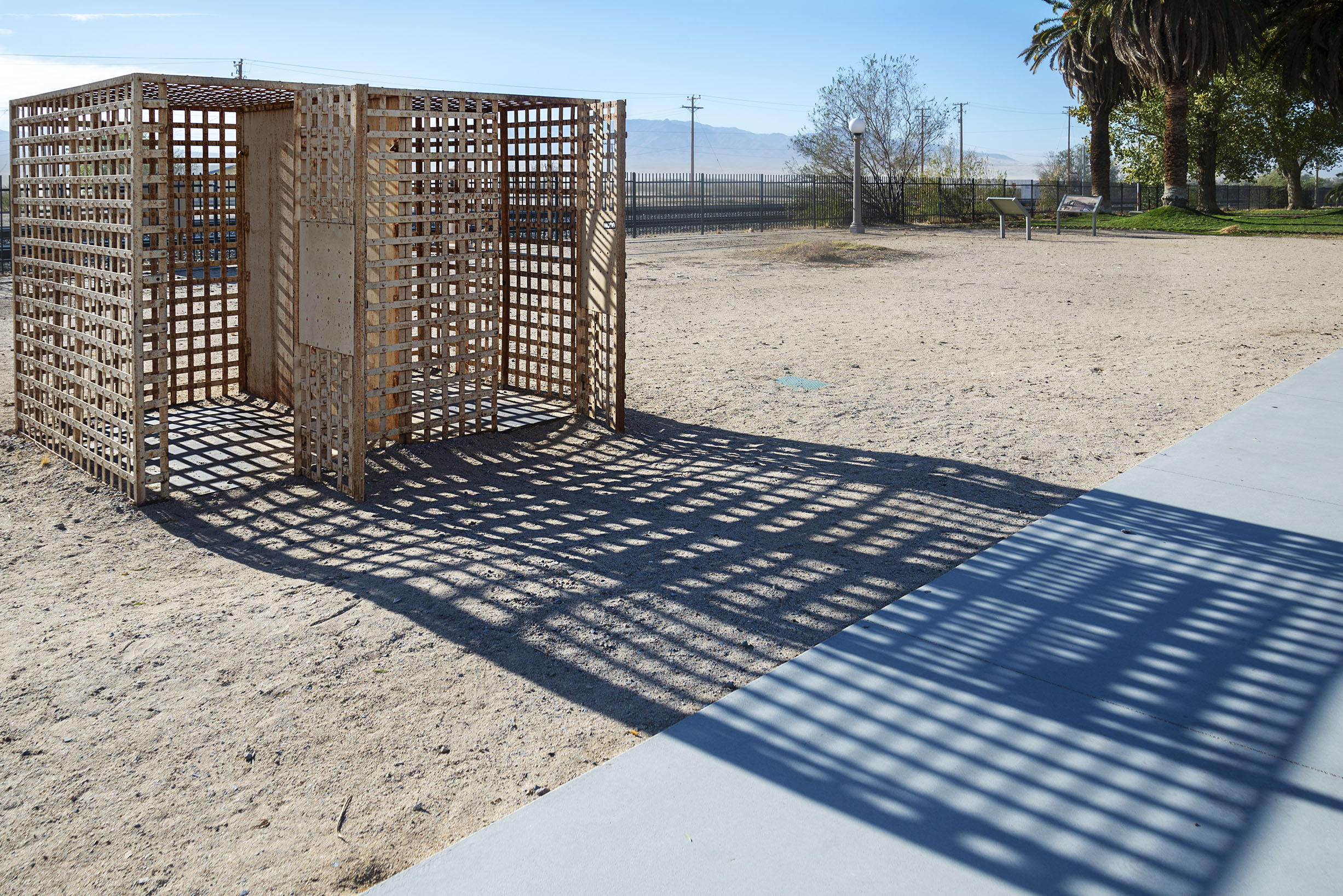
In addition to the historic translation, visitors may also view the Kelso Jail. These human cages were utilized from the mid 1940’s all the way to 1985. To lock up, for a night or two, the town drunks who became unruly. Neither the heat or the cold of the Mojave made these cages very comfortable.

But by all accounts, this sort of imprisonment hasn’t gone away. Only from here.

You know you’re in downtown Kelso when…you see the Post Office. Open from 1905, through Kelso’s boom years during WW2, and finally closing in 1962.

Ghost Town…ghost sign.

Kelso 90920

Foundation and Fireplace, Kelso Ghost Town

The warmth and comfort once provided, now a ghost town ruin.